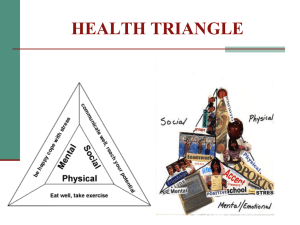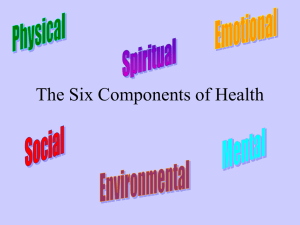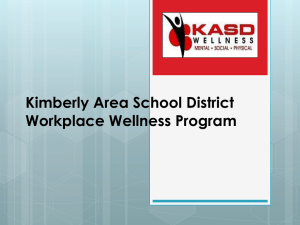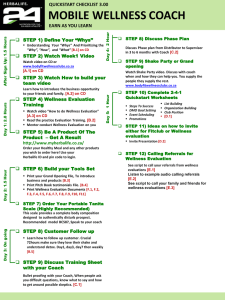File - indydovesems
advertisement
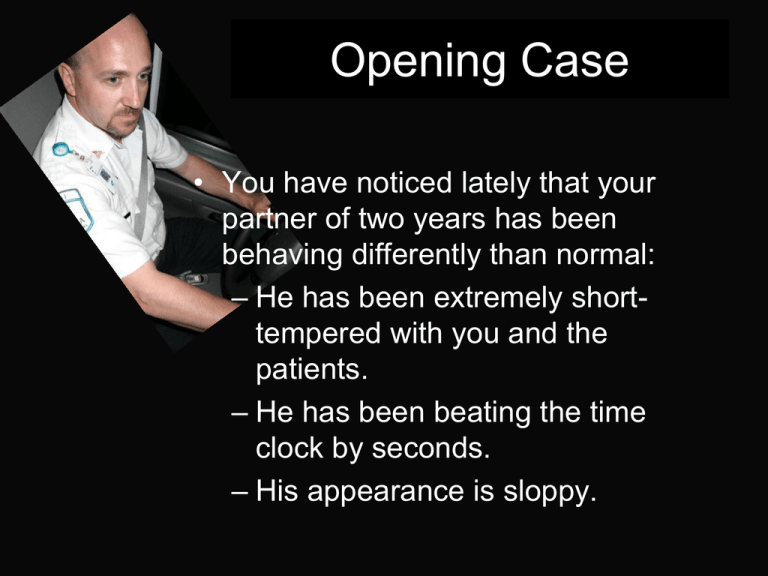
Opening Case • You have noticed lately that your partner of two years has been behaving differently than normal: – He has been extremely shorttempered with you and the patients. – He has been beating the time clock by seconds. – His appearance is sloppy. Opening Case Nothing • When you attempt to find out what is going on with your partner, he tells you, “Nothing.” Question: What could be affecting your partner’s behavior? A. Stress B. Drugs/Alcohol C. Burnout D. All of the above Question: • What should you do to help your partner? Introduction Copyright © The McGraw-Hill Companies, Inc. Permission required for reproduction or display Introduction • Paramedics: – work 45–60 hrs/week – irregular hours – lift, carry, walk, stand, crawl, kneel to perform duties – work in all weather and temperature conditions Disease, Injury, and Death Copyright © The McGraw-Hill Companies, Inc. Permission required for reproduction or display Life Expectancy in U.S. Morbidity and Mortality • Analysis helps us understand factors that affect our health and safety Age <65 = Preventable 83% of time Wellness • Optimal health • Maintaining quality of life • Requires balance in all aspects of life Disease, Injury, and Death • Know your risk factors – Those that can be controlled and those that cannot be controlled Reducing the Threat of Disease and Injury Copyright © The McGraw-Hill Companies, Inc. Permission required for reproduction or display Factors Influencing Wellness • • • • Lifestyle behaviors Environmental factors Health care received Genetic factors How to Promote Wellness • • • • Smoking cessation Cardiovascular disease prevention Stroke prevention Cancer prevention Wellness Copyright © The McGraw-Hill Companies, Inc. Permission required for reproduction or display Dimensions of Wellness • • • • • • Physical Intellectual Emotional Social Environmental Spiritual Physical Wellness • • • • • Exercise Eating nutritiously Regular sleep Regular doctor visits Avoiding risky behaviors— alcohol and drug use • Taking medication Fitting in a Workout • Play sports with your partner while waiting for a call • Use the back bumper of the ambulance to stretch Intellectual and Emotional Wellness • • • • • Healthy decision-making Flexibility to life’s changes Ability to think under stress Ability to express emotions Knowing your limits Social Wellness • • • • Interacting well with others Appreciation of diversity Support network—friends, family Connectedness to the community Environmental Wellness • Protecting yourself from hazards – BSI • Scene safety at all times Spiritual Wellness • Provides life with meaning • Promotes ethical and moral thinking • Maintains faith and hope Occupational Wellness • Ability to find meaning in your occupation • Ability to find satisfaction in your occupation • Ability to accomplish objectives required for the job High-Level Wellness • Wellness is always changing • Paramedic’s duty to promote wellness – Through education – By example Physical Fitness • Health-related • Skill-related Health-Related Fitness • Cardiovascular endurance • Muscular strength • Muscular endurance • Muscular flexibility • Body composition Skill-Related Fitness • Athletic performance • • • • • • Agility Speed Power Stamina Balance Coordination Benefits and Maintenance • • • • • Ability to control risk factors Improve energy level Work out with crew members Join a team Encourage healthy behaviors Nutrition Copyright © The McGraw-Hill Companies, Inc. Permission required for reproduction or display Healthy Diet • Be aware of caloric intake • Know what your are eating – carbohydrates – protein – fats Achieving a Health Diet • • • • Read labels Plan ahead Be realistic about snacks Be creative Eating on the Go • Preplan, bring a cooler – Bring fruits and vegetables • Choose grocery store over fast food Weight Control Copyright © The McGraw-Hill Companies, Inc. Permission required for reproduction or display Weight Control • • • • Set realistic goals Devise a plan Ask for help Exercise regularly The Hours We Keep • Sleep does many things – Decreasing stress – Fighting off illness, injury, and disease • Lack of sleep can lead to – Unhealthy weight gain Stress Copyright © The McGraw-Hill Companies, Inc. Permission required for reproduction or display Good/Bad Stress • Eustress—stress has positive effects • Distress—stress has negative effects Stress • Fight or flight response – causes physiological and psychological reactions General Adaptive Syndrome • Research based on Hans Selye • Three stages – alarm – resistance – exhaustion Alarm • Occurs when presented with stressor • Increase in – Heart rate – Blood pressure – Mental acuity – Possible anxiety and sweating Resistance • New homeostasis or baseline – Body reacts to the stressors – Prolonged by • caffeine • smoking Exhaustion • Depletion of the body’s resources • Inability of the body to react to stress – causing disease or death Warning Signs • • • • • • Headaches Sleep disturbances Short temper Job dissatisfaction Digestive problems Difficulty concentrating What to do about stress? • Reduce physiological effects – deep breathing • Learn to manage external stressors – time management • Adjust perceptions about stressors – priorities Critical Incident Stress Copyright © The McGraw-Hill Companies, Inc. Permission required for reproduction or display Critical Incident Stress • Experienced by many high-stress professionals • Has no time limit – Short-term and long-term responses • Causes burnout • Needs to be addressed every time Critical Incident Stress • Exercise, nutrition, and relaxation techniques help control effects • Preincident education and follow-up counseling can offer further help Healthy Choices • Maintain proper body weight • Eat a nutritious diet • Exercise • Manage stress Healthy Choices • Eliminating the use of tobacco/drugs • Using alcohol in moderation • Avoiding stimulants Results of Stress • Cardiovascular disease • Stroke • Many other diseases Summary • Wellness is a choice, not simply the absence of disease • Occurs when poor behaviors are removed and replaced by healthy choices Summary • Individual responsibilities in maintaining wellness • Know behaviors that promote wellness into your lifestyle • Strategies for dealing with stress in EMS The END Copyright © The McGraw-Hill Companies, Inc. Permission required for reproduction or display


